Diagnostic Efficacy of Carotid Ultrasound for Predicting the Risk of Perioperative Hypotension or Fluid Responsiveness: A Meta-Analysis
Abstract
1. Introduction
2. Materials and Methods
2.1. Study Protocol
2.2. Data Source and Literature Search
2.3. Inclusion and Exclusion Criteria
2.4. Data Extraction
2.5. Outcomes and Definitions
2.6. Quality Assessment
2.7. Statistical Analysis
3. Results
3.1. Study Selection and Study Characteristics
3.2. Outcomes
3.2.1. Diagnostic Efficacy of Carotid Ultrasonography for Predicting Perioperative Hypotension and Fluid Responsiveness
3.2.2. Publication Bias
3.2.3. Fagan Nomogram for Post-Test Probabilities
4. Discussion
5. Conclusions
Supplementary Materials
Author Contributions
Funding
Institutional Review Board Statement
Informed Consent Statement
Data Availability Statement
Conflicts of Interest
References
- Czajka, S.; Putowski, Z.; Krzych, Ł.J. Post-induction hypotension and intraoperative hypotension as potential separate risk factors for the adverse outcome: A cohort study. J. Anesth. 2023, 37, 442–450. [Google Scholar] [CrossRef] [PubMed]
- Temesgen, N.; Fenta, E.; Eshetie, C.; Gelaw, M. Early intraoperative hypotension and its associated factors among surgical patients undergoing surgery under general anesthesia: An observational study. Ann. Med. Surg. 2021, 71, 102835. [Google Scholar] [CrossRef] [PubMed]
- Huang, X.; Lu, X.; Guo, C.; Lin, S.; Zhang, Y.; Zhang, X.; Cheng, E.; Liu, J. Effect of preoperative risk on the association between intraoperative hypotension and postoperative acute kidney injury in cardiac surgery. Anaesth. Crit. Care Pain Med. 2023, 42, 101233. [Google Scholar] [CrossRef] [PubMed]
- Bijker, J.B.; van Klei, W.A.; Kappen, T.H.; van Wolfswinkel, L.; Moons, K.G.; Kalkman, C.J. Incidence of intraoperative hypotension as a function of the chosen definition: Literature definitions applied to a retrospective cohort using automated data collection. Anesthesiology 2007, 107, 213–220. [Google Scholar] [CrossRef] [PubMed]
- Schonberger, R.B.; Dai, F.; Michel, G.; Vaughn, M.T.; Burg, M.M.; Mathis, M.; Kheterpal, S.; Akhtar, S.; Shah, N.; Bardia, A. Association of propofol induction dose and severe pre-incision hypotension among surgical patients over age 65. J. Clin. Anesth. 2022, 80, 110846. [Google Scholar] [CrossRef]
- Duan, W.; Zhou, C.M.; Yang, J.J.; Zhang, Y.; Li, Z.P.; Ma, D.Q.; Yang, J.J. A long duration of intraoperative hypotension is associated with postoperative delirium occurrence following thoracic and orthopedic surgery in elderly. J. Clin. Anesth. 2023, 88, 111125. [Google Scholar] [CrossRef]
- Putowski, Z.; Majewska, K.; Gruca, K.; Zimnoch, A.; Szczepańska, A.; Krzych, Ł.J.; Jabłońska, B.; Mrowiec, S. Intraoperative Hypotension and Its Association with Postoperative Acute Kidney Injury in Patients Undergoing Pancreaticoduodenectomy: A 5-Year, Single-Center, Retrospective Cohort Study. Med. Sci. Monit. Int. Med. J. Exp. Clin. Res. 2023, 29, e938945. [Google Scholar] [CrossRef]
- Maleczek, M.; Laxar, D.; Geroldinger, A.; Kimberger, O. Intraoperative Hypotension Is Associated with Postoperative Nausea and Vomiting in the PACU: A Retrospective Database Analysis. J. Clin. Med. 2023, 12, 2009. [Google Scholar] [CrossRef]
- Zhang, Y.; Li, S.; Li, Z.; Chen, J.; Tan, H. Intraoperative Diastolic Hypotension-Prolonged Postoperative Hospital Stay in Patients with Gastric Cancer: A Retrospective Cohort Study with Propensity Score Matching. Int. J. Gen. Med. 2022, 15, 8467–8479. [Google Scholar] [CrossRef]
- Shaw, A.D.; Khanna, A.K.; Smischney, N.J.; Shenoy, A.V.; Boero, I.J.; Bershad, M.; Hwang, S.; Chen, Q.; Stapelfeldt, W.H. Intraoperative hypotension is associated with persistent acute kidney disease after noncardiac surgery: A multicentre cohort study. Br. J. Anaesth. 2022, 129, 13–21. [Google Scholar] [CrossRef]
- Bijker, J.B.; van Klei, W.A.; Vergouwe, Y.; Eleveld, D.J.; van Wolfswinkel, L.; Moons, K.G.; Kalkman, C.J. Intraoperative hypotension and 1-year mortality after noncardiac surgery. Anesthesiology 2009, 111, 1217–1226. [Google Scholar] [CrossRef] [PubMed]
- van Waes, J.A.; van Klei, W.A.; Wijeysundera, D.N.; van Wolfswinkel, L.; Lindsay, T.F.; Beattie, W.S. Association between Intraoperative Hypotension and Myocardial Injury after Vascular Surgery. Anesthesiology 2016, 124, 35–44. [Google Scholar] [CrossRef] [PubMed]
- Sun, L.Y.; Chung, A.M.; Farkouh, M.E.; van Diepen, S.; Weinberger, J.; Bourke, M.; Ruel, M. Defining an Intraoperative Hypotension Threshold in Association with Stroke in Cardiac Surgery. Anesthesiology 2018, 129, 440–447. [Google Scholar] [CrossRef] [PubMed]
- Nugent, K.; Berdine, G.; Pena, C. Does Fluid Administration Based on Fluid Responsiveness Tests such as Passive Leg Raising Improve Outcomes in Sepsis? Curr. Cardiol. Rev. 2022, 18, 18–23. [Google Scholar] [CrossRef]
- Monnet, X.; Marik, P.E.; Teboul, J.L. Prediction of fluid responsiveness: An update. Ann. Intensive Care 2016, 6, 111. [Google Scholar] [CrossRef] [PubMed]
- La Via, L.; Astuto, M.; Dezio, V.; Muscarà, L.; Palella, S.; Zawadka, M.; Vignon, P.; Sanfilippo, F. Agreement between subcostal and transhepatic longitudinal imaging of the inferior vena cava for the evaluation of fluid responsiveness: A systematic review. J. Crit. Care 2022, 71, 154108. [Google Scholar] [CrossRef]
- Orso, D.; Paoli, I.; Piani, T.; Cilenti, F.L.; Cristiani, L.; Guglielmo, N. Accuracy of Ultrasonographic Measurements of Inferior Vena Cava to Determine Fluid Responsiveness: A Systematic Review and Meta-Analysis. J. Intensive Care Med. 2020, 35, 354–363. [Google Scholar] [CrossRef]
- Monnet, X.; Marik, P.; Teboul, J.L. Passive leg raising for predicting fluid responsiveness: A systematic review and meta-analysis. Intensive Care Med. 2016, 42, 1935–1947. [Google Scholar] [CrossRef]
- Chen, Y.; Liu, Z.; Fang, J.; Xie, Y.; Zhang, M.; Yang, J. Correlation of carotid corrected flow time and respirophasic variation in blood flow peak velocity with stroke volume variation in elderly patients under general anaesthesia. BMC Anesthesiol. 2022, 22, 246. [Google Scholar] [CrossRef]
- Jung, S.; Kim, J.; Na, S.; Nam, W.S.; Kim, D.H. Ability of Carotid Corrected Flow Time to Predict Fluid Responsiveness in Patients Mechanically Ventilated Using Low Tidal Volume after Surgery. J. Clin. Med. 2021, 10, 2676. [Google Scholar] [CrossRef]
- Kim, D.H.; Shin, S.; Kim, N.; Choi, T.; Choi, S.H.; Choi, Y.S. Carotid ultrasound measurements for assessing fluid responsiveness in spontaneously breathing patients: Corrected flow time and respirophasic variation in blood flow peak velocity. Br. J. Anaesth. 2018, 121, 541–549. [Google Scholar] [CrossRef]
- Singla, D.; Gupta, B.; Varshney, P.; Mangla, M.; Walikar, B.N.; Jamir, T. Role of carotid corrected flow time and peak velocity variation in predicting fluid responsiveness: A systematic review and meta-analysis. Korean J. Anesthesiol. 2022, 76, 183. [Google Scholar] [CrossRef]
- Maitra, S.; Baidya, D.K.; Anand, R.K.; Subramanium, R.; Bhattacharjee, S. Carotid Artery Corrected Flow Time and Respiratory Variations of Peak Blood Flow Velocity for Prediction of Hypotension After Induction of General Anesthesia in Adult Patients Undergoing Elective Surgery: A Prospective Observational Study. J. Ultrasound Med. Off. J. Am. Inst. Ultrasound Med. 2020, 39, 721–730. [Google Scholar] [CrossRef]
- Wang, J.; Li, Y.; Su, H.; Zhao, J.; Tu, F. Carotid artery corrected flow time and respiratory variations of peak blood flow velocity for prediction of hypotension after induction of general anesthesia in elderly patients. BMC Geriatr. 2022, 22, 882. [Google Scholar] [CrossRef]
- Hassan, S.; Turner, P. Systolic time intervals: A review of the method in the non-invasive investigation of cardiac function in health, disease and clinical pharmacology. Postgrad. Med. J. 1983, 59, 423–434. [Google Scholar] [CrossRef] [PubMed]
- Whiting, P.F.; Rutjes, A.W.; Westwood, M.E.; Mallett, S.; Deeks, J.J.; Reitsma, J.B.; Leeflang, M.M.G.; Sterne, J.A.C.; Bossuyt, P.M.M.; the QUADAS-2 Group. QUADAS-2: A revised tool for the quality assessment of diagnostic accuracy studies. Ann. Intern. Med. 2011, 155, 529–536. [Google Scholar] [CrossRef] [PubMed]
- Jones, C.M.; Athanasiou, T. Summary receiver operating characteristic curve analysis techniques in the evaluation of diagnostic tests. Ann. Thorac. Surg. 2005, 79, 16–20. [Google Scholar] [CrossRef]
- Tsai, W.-W.; Hung, K.-C.; Huang, Y.-T.; Yu, C.-H.; Lin, C.-H.; Chen, I.-W.; Sun, C.-K. Diagnostic efficacy of sonographic measurement of laryngeal air column width difference for predicting the risk of post-extubation stridor: A meta-analysis of observational studies. Front. Med. 2023, 10, 1109681. [Google Scholar] [CrossRef]
- Dong, H.; Geng, Z.; Zhang, Y.; Liu, W.; Lu, X.; Yang, Y. Predictive value of carotid artery corrected blood flow time and heart rate in elderly patients with hypotension after subarachnoid block. J. Clin. Anesthesiol. 2022, 38, 608–612. [Google Scholar]
- Kim, H.J.; Choi, Y.S.; Kim, S.H.; Lee, W.; Kwon, J.Y.; Kim, D.H. Predictability of preoperative carotid artery-corrected flow time for hypotension after spinal anaesthesia in patients undergoing caesarean section: A prospective observational study. Eur. J. Anaesthesiol. 2021, 38, 394–401. [Google Scholar] [CrossRef] [PubMed]
- Song, Y.; Kwak, Y.L.; Song, J.W.; Kim, Y.J.; Shim, J.K. Respirophasic carotid artery peak velocity variation as a predictor of fluid responsiveness in mechanically ventilated patients with coronary artery disease. Br. J. Anaesth. 2014, 113, 61–66. [Google Scholar] [CrossRef]
- Tang, X.; Chen, Q.; Huang, Z.; An, R.; Liang, J.; Liu, H. Comparison of the carotid corrected flow time and tidal volume challenge for assessing fluid responsiveness in robot-assisted laparoscopic surgery. medRxiv 2023. [Google Scholar] [CrossRef]
- Wang, H.; Chen, W.; Cheng, H.; Liu, C.; Yao, W.; Ding, F.; Wang, Y.; Chen, Y. Value of corrected flow time in common carotid artery in predicting volume responsiveness under mechanical ventilation. Shock 2022, 58, 28–33. [Google Scholar] [CrossRef] [PubMed]
- Xu, L.; Dai, S.; Shen, J.; Lv, C.; Tang, Y.; Chen, X. The predictive ability of carotid artery corrected flow time and respirophasic variation in blood flow peak velocity measured by ultrasonography for fluid responsiveness in parturients for cesarean delivery. Minerva Anestesiol. 2020, 86, 1039–1046. [Google Scholar] [CrossRef]
- Davies, S.J.; Vistisen, S.T.; Jian, Z.; Hatib, F.; Scheeren, T.W.L. Ability of an Arterial Waveform Analysis-Derived Hypotension Prediction Index to Predict Future Hypotensive Events in Surgical Patients. Anesth. Analg. 2020, 130, 352–359. [Google Scholar] [CrossRef] [PubMed]
- Murabito, P.; Astuto, M.; Sanfilippo, F.; La Via, L.; Vasile, F.; Basile, F.; Cappellani, A.; Longhitano, L.; Distefano, A.; Li Volti, G. Proactive Management of Intraoperative Hypotension Reduces Biomarkers of Organ Injury and Oxidative Stress during Elective Non-Cardiac Surgery: A Pilot Randomized Controlled Trial. J. Clin. Med. 2022, 11, 392. [Google Scholar] [CrossRef]
- Wijnberge, M.; Geerts, B.F.; Hol, L.; Lemmers, N.; Mulder, M.P.; Berge, P.; Schenk, J.; Terwindt, L.E.; Hollmann, M.W.; Vlaar, A.P.; et al. Effect of a Machine Learning-Derived Early Warning System for Intraoperative Hypotension vs Standard Care on Depth and Duration of Intraoperative Hypotension During Elective Noncardiac Surgery: The HYPE Randomized Clinical Trial. JAMA 2020, 323, 1052–1060. [Google Scholar] [CrossRef]
- Chen, Y.; Guo, X.; Fu, J.; Dong, T.; Liu, X.; Lv, H. Accuracy of stroke volume variation and pulse pressure variation to predict fluid responsiveness in patients with thoracic kyphosis. Ann. Palliat. Med. 2021, 10, 7571–7578. [Google Scholar] [CrossRef] [PubMed]
- Kim, D.H.; Shin, S.; Kim, J.Y.; Kim, S.H.; Jo, M.; Choi, Y.S. Pulse pressure variation and pleth variability index as predictors of fluid responsiveness in patients undergoing spinal surgery in the prone position. Ther. Clin. Risk Manag. 2018, 14, 1175–1183. [Google Scholar] [CrossRef]
- Zlicar, M.; Novak-Jankovic, V.; Blagus, R.; Cecconi, M. Predictive values of pulse pressure variation and stroke volume variation for fluid responsiveness in patients with pneumoperitoneum. J. Clin. Monit. Comput. 2018, 32, 825–832. [Google Scholar] [CrossRef]
- Mukai, A.; Suehiro, K.; Kimura, A.; Kodama, S.; Tanaka, K.; Mori, T.; Nishikawa, K. Impact of deep breathing on predictability of stroke volume variation in spontaneous breathing patients. Acta Anaesthesiol. Scand. 2020, 64, 648–655. [Google Scholar] [CrossRef]
- Marik, P.E.; Cavallazzi, R.; Vasu, T.; Hirani, A. Dynamic changes in arterial waveform derived variables and fluid responsiveness in mechanically ventilated patients: A systematic review of the literature. Crit. Care Med. 2009, 37, 2642–2647. [Google Scholar] [CrossRef]
- Cannesson, M.; Vallet, B.; Michard, F. Pulse pressure variation and stroke volume variation: From flying blind to flying right? BJA Br. J. Anaesthesia. 2009, 103, 896–899. [Google Scholar] [CrossRef] [PubMed]
- Sánchez, J.I.A.; Ruiz, J.D.C.; Fernández, J.J.D.; Ospina-Tascón, G.A.; Martínez, L.E.C. Use of pulse pressure variation as predictor of fluid responsiveness in patients ventilated with low tidal volume: A systematic review and meta-analysis. Clin. Med. Insights Circ. Respir. Pulm. Med. 2020, 14, 1179548420901518. [Google Scholar]
- De Backer, D.; Heenen, S.; Piagnerelli, M.; Koch, M.; Vincent, J.-L. Pulse pressure variations to predict fluid responsiveness: Influence of tidal volume. Intensive Care Med. 2005, 31, 517–523. [Google Scholar] [CrossRef]
- Doctor, M.; Siadecki, S.D.; Cooper, D.; Rose, G., Jr.; Drake, A.B.; Ku, M.; Suprun, M.; Saul, T. Reliability, Laterality and the Effect of Respiration on the Measured Corrected Flow Time of the Carotid Arteries. J. Emerg. Med. 2017, 53, 91–97. [Google Scholar] [CrossRef] [PubMed]
- Abbasi, A.; Azab, N.; Nayeemuddin, M.; Schick, A.; Lopardo, T.; Phillips, G.S.; Merchant, R.C.; Levy, M.M.; Blaivas, M.; Corl, K.A. Change in Carotid Blood Flow and Carotid Corrected Flow Time Assessed by Novice Sonologists Fails to Determine Fluid Responsiveness in Spontaneously Breathing Intensive Care Unit Patients. Ultrasound Med. Biol. 2020, 46, 2659–2666. [Google Scholar] [CrossRef] [PubMed]
- Abbasi, A.; Nayeemuddin, M.; Azab, N.; Schick, A.; Lopardo, T.; Phillips, G.S.; Merchant, R.C.; Levy, M.M.; Blaivas, M.; Corl, K.A. Respiratory Variation in Carotid Artery Peak Systolic Velocity Is Unable to Predict Fluid Responsiveness in Spontaneously Breathing Critically Ill Patients When Assessed by Novice Physician Sonologists. J. Intensive Care Med. 2021, 36, 885–892. [Google Scholar] [CrossRef]
- Dai, S.; Li, X.; Yang, Y.; Cao, Y.; Wang, E.; Dong, Z. A retrospective cohort analysis for the risk factors of intraoperative hypotension. Int. J. Clin. Pract. 2020, 74, e13521. [Google Scholar] [CrossRef]
- Vaidya, G.N.; Kolodziej, A.; Stoner, B.; Galaviz, J.V.; Cao, X.; Heier, K.; Thompson, M.; Birks, E.; Campbell, K. Bedside ultrasound of the internal jugular vein to assess fluid status and right ventricular function: The POCUS-JVD study. Am. J. Emerg. Med. 2023, 70, 151–156. [Google Scholar] [CrossRef]

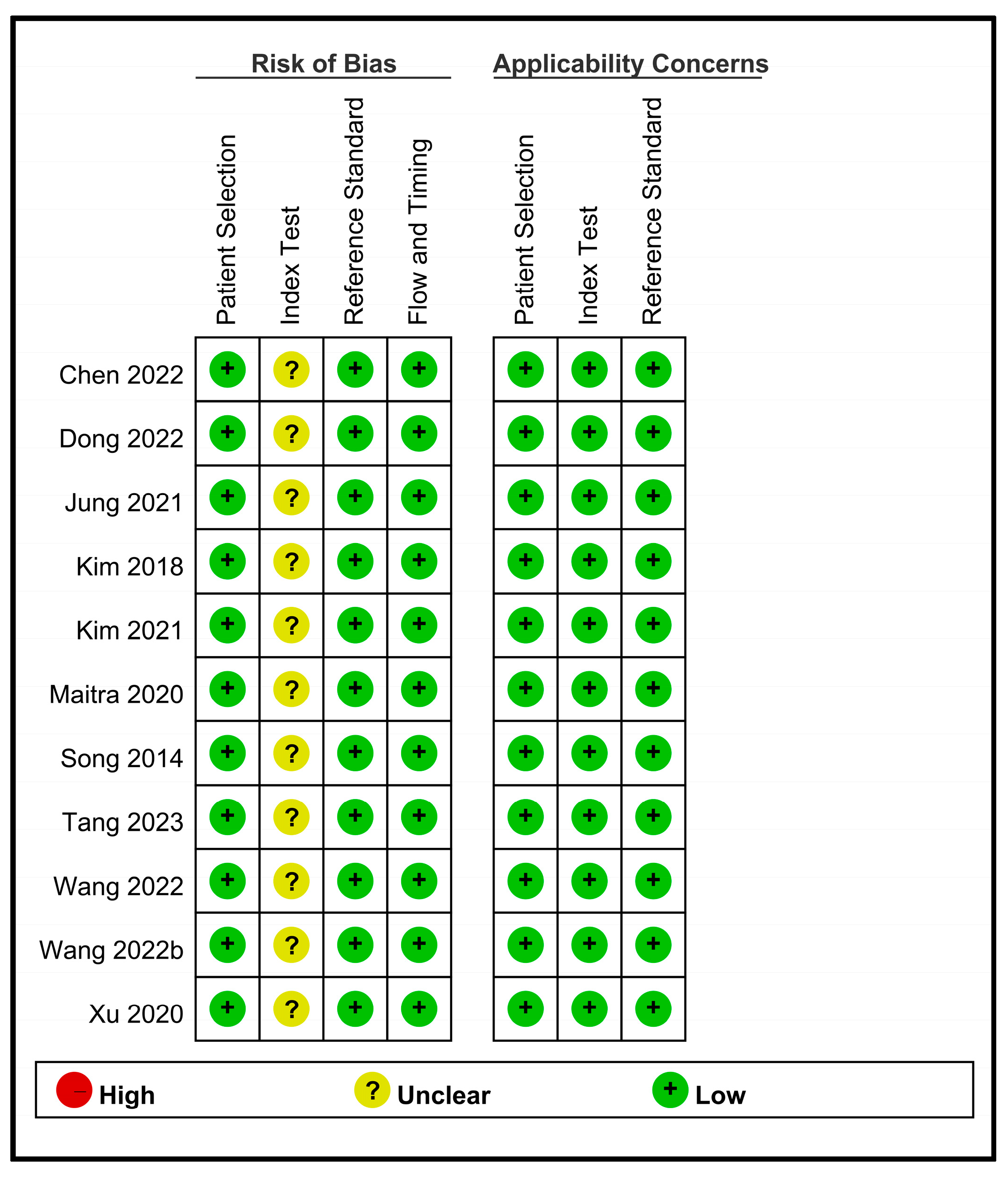
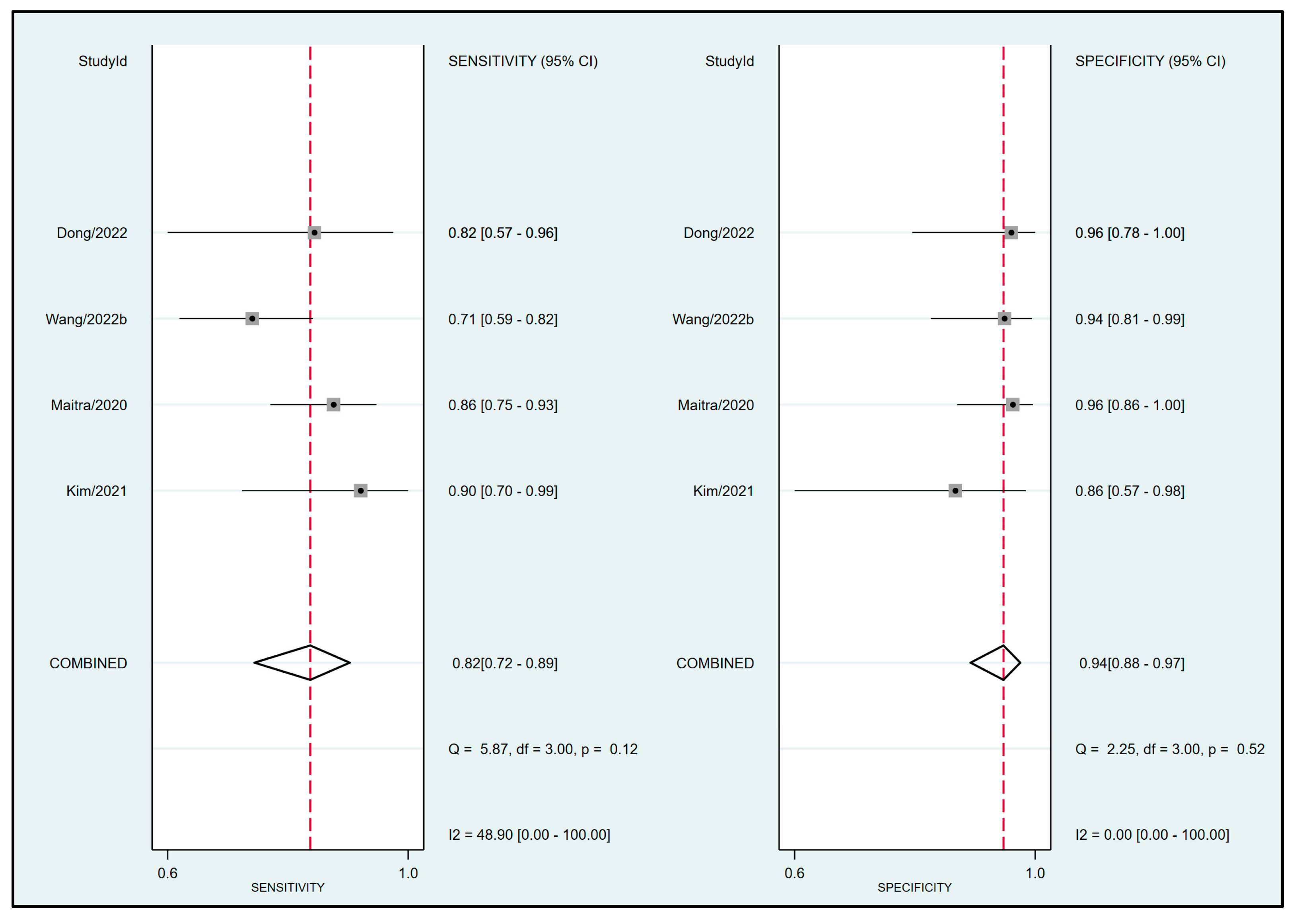
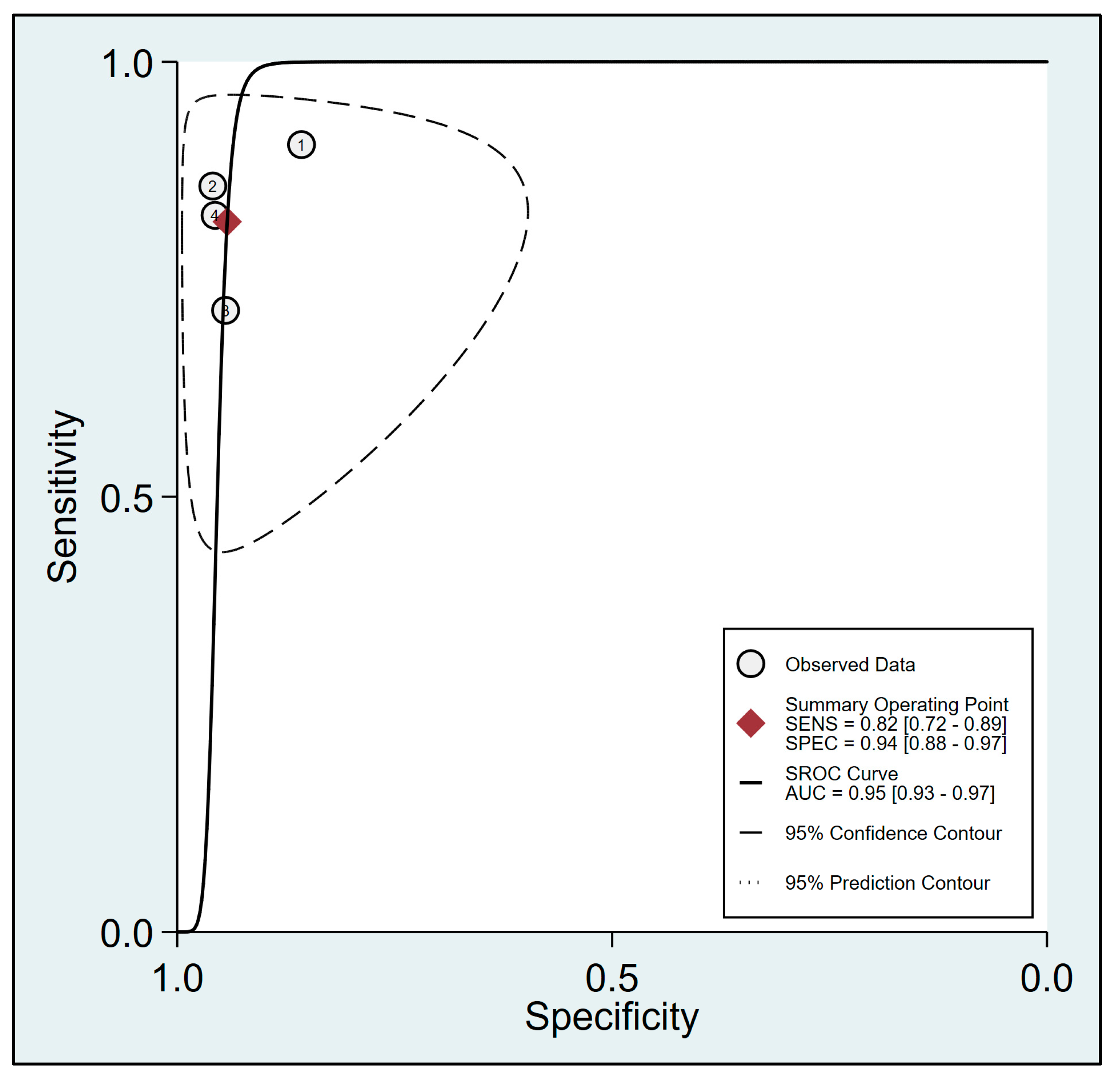
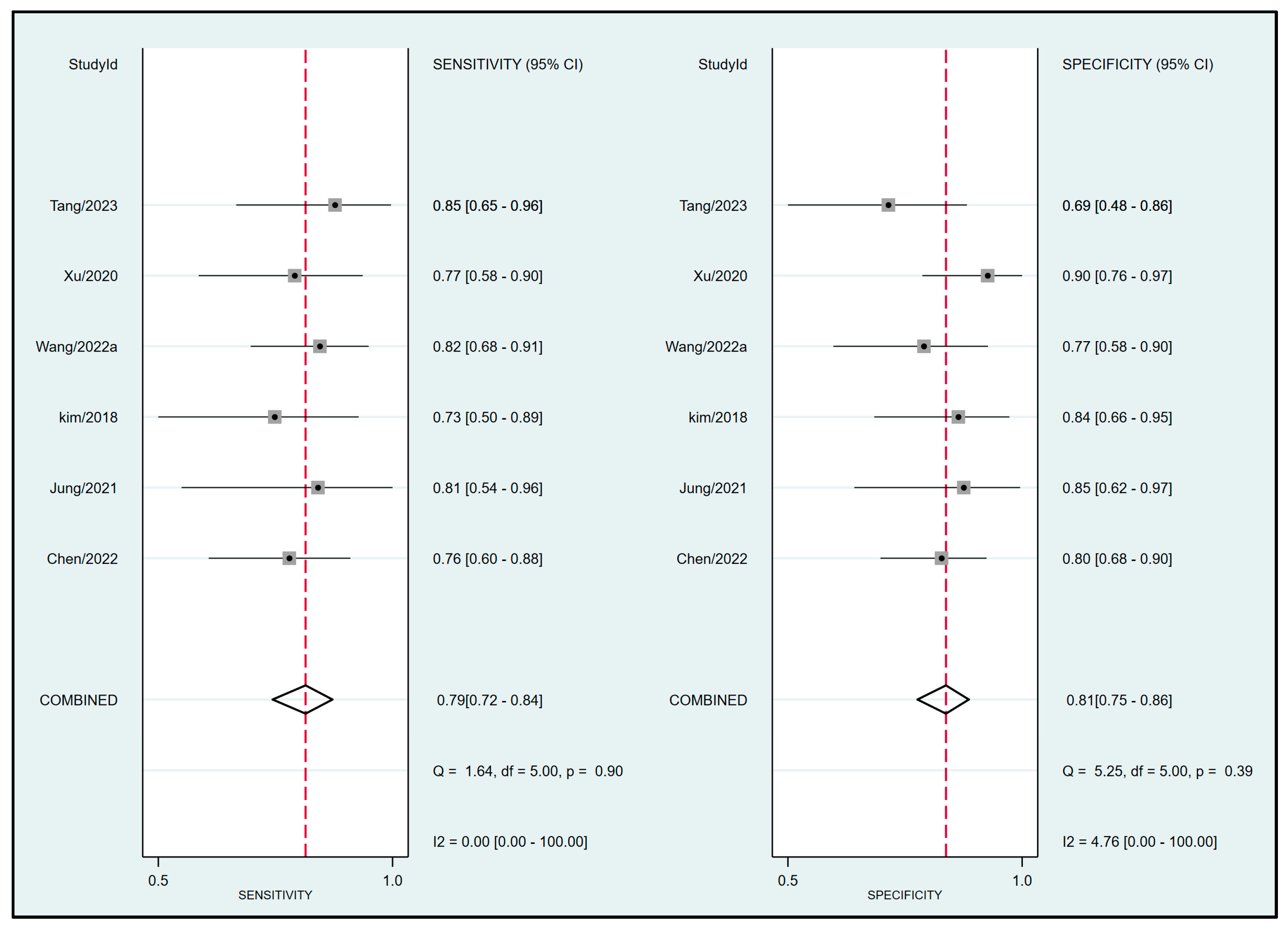
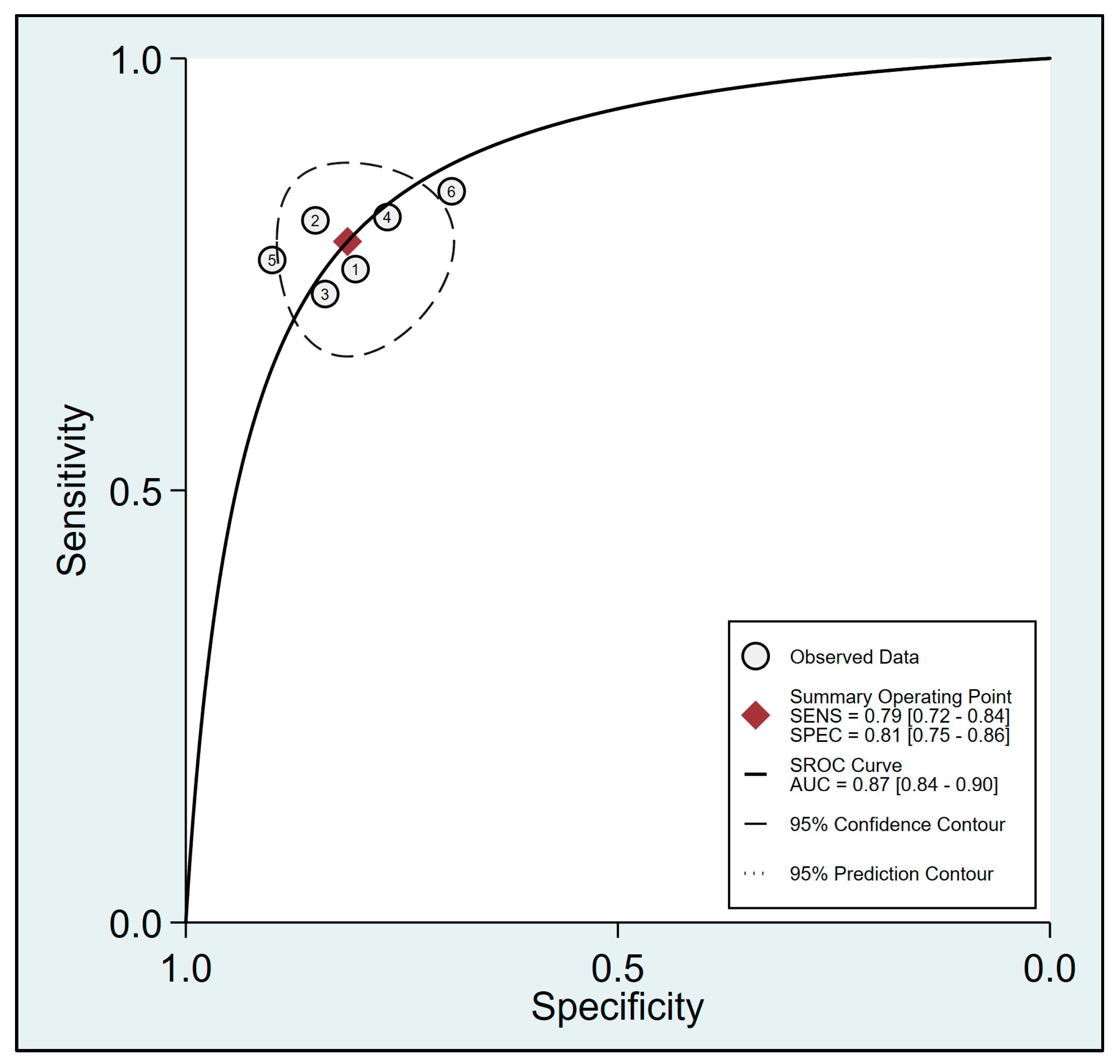
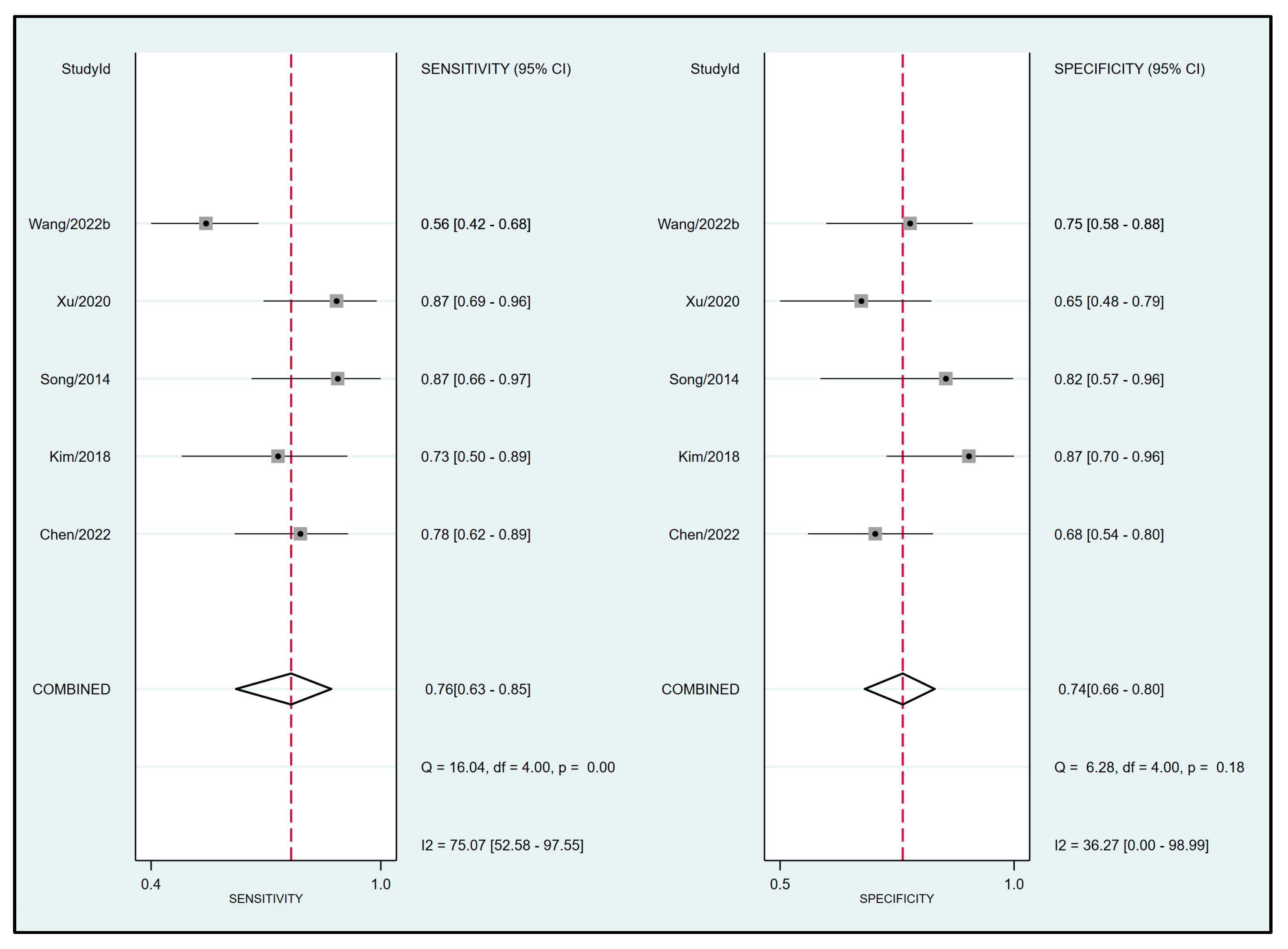


| Studies | Age (Years) † | Male (%) | N | ASA-PS | Type of Study | Time of Ultrasonic Measurement | Outcome (Incidence%) | Cut-Off Value FTc (ms) | Country |
|---|---|---|---|---|---|---|---|---|---|
| Chen 2022 [19] | 71.6 | 62.9 | 97 | 16/52/29 | Pro | Before AI | FR (42.4) | 340.74 | China |
| Dong 2022 [29] | 79.1 vs. 71.2 ‡ | 52.5 | 40 | 0/31/9 | Pro | Before SA | Hypo (43) | 323.4 | China |
| Jung 2021 [20] | 55.0 | 61.1 | 36 | 13/18/5 | Pro | Post-op | FR (44.4) | 345.1 | Korea |
| Kim 2018 [21] | 54.0 | 34 | 53 | 28/21/4 | Pro | Before AI | FR (42) | 349.4 | Korea |
| Kim 2021 [30] | 35 | 0 | 35 | NA ⁋ | Pro | Before SA | Hypo (60) | 346.4 | Korea |
| Maitra 2020 [23] | 40.7 | 48.2 | 112 | 63/47/0 | Pro | Before AI | Hypo (56.3) | 330.2 | India |
| Song 2014 [31] | 66 vs. 67 ‡ | 67.5 | 40 | NA | Pro | After AI | FR (57.50) | - | Korea |
| Tang 2023 [32] | 50.98 | NA | 52 | 0/43/9 | Pro | After AI | FR (50) | 356.5 | China |
| Wang 2022a [33] | 29.3 vs 28.2 ‡ | 49.4 | 79 | 0/40/29 | Pro | After AI | FR (62) | 331.93 | China |
| Wang 2022b [24] | 69 vs. 68 ‡ | 65.7 | 99 | 88/11/0 | Pro | Before AI | Hypo (63.6) | 379.1 | China |
| Xu 2020 [34] | 33 vs. 34 ‡ | 0 | 70 | 50/20/0 | Pro | Before SA and EA | FR (42.90) | 313.8 | China |
Disclaimer/Publisher’s Note: The statements, opinions and data contained in all publications are solely those of the individual author(s) and contributor(s) and not of MDPI and/or the editor(s). MDPI and/or the editor(s) disclaim responsibility for any injury to people or property resulting from any ideas, methods, instructions or products referred to in the content. |
© 2023 by the authors. Licensee MDPI, Basel, Switzerland. This article is an open access article distributed under the terms and conditions of the Creative Commons Attribution (CC BY) license (https://creativecommons.org/licenses/by/4.0/).
Share and Cite
Hung, K.-C.; Huang, Y.-T.; Tsai, W.-W.; Tan, P.-H.; Wu, J.-Y.; Huang, P.-Y.; Liu, T.-H.; Chen, I.-W.; Sun, C.-K. Diagnostic Efficacy of Carotid Ultrasound for Predicting the Risk of Perioperative Hypotension or Fluid Responsiveness: A Meta-Analysis. Diagnostics 2023, 13, 2290. https://doi.org/10.3390/diagnostics13132290
Hung K-C, Huang Y-T, Tsai W-W, Tan P-H, Wu J-Y, Huang P-Y, Liu T-H, Chen I-W, Sun C-K. Diagnostic Efficacy of Carotid Ultrasound for Predicting the Risk of Perioperative Hypotension or Fluid Responsiveness: A Meta-Analysis. Diagnostics. 2023; 13(13):2290. https://doi.org/10.3390/diagnostics13132290
Chicago/Turabian StyleHung, Kuo-Chuan, Yen-Ta Huang, Wen-Wen Tsai, Ping-Heng Tan, Jheng-Yan Wu, Po-Yu Huang, Ting-Hui Liu, I-Wen Chen, and Cheuk-Kwan Sun. 2023. "Diagnostic Efficacy of Carotid Ultrasound for Predicting the Risk of Perioperative Hypotension or Fluid Responsiveness: A Meta-Analysis" Diagnostics 13, no. 13: 2290. https://doi.org/10.3390/diagnostics13132290
APA StyleHung, K.-C., Huang, Y.-T., Tsai, W.-W., Tan, P.-H., Wu, J.-Y., Huang, P.-Y., Liu, T.-H., Chen, I.-W., & Sun, C.-K. (2023). Diagnostic Efficacy of Carotid Ultrasound for Predicting the Risk of Perioperative Hypotension or Fluid Responsiveness: A Meta-Analysis. Diagnostics, 13(13), 2290. https://doi.org/10.3390/diagnostics13132290






